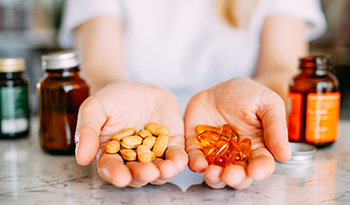Bir Doktora Göre Sırt Ağrısını Gidermenin 8 Yolu

Sırt ağrısı, işten kaçmanın yaygın bir nedenidir ve aslında dünya çapında bir numaralı sakatlık nedenidir. Aslında uzmanlar, her 5 kişiden 4'ünün hayatlarının bir noktasında sırt ağrısı yaşayacağını tahmin ediyor.
Sırt ağrısı çok düzenli bir olay olduğundan, bu durumu yönetmek için neler yapılabileceğini bilmek iyidir. Rahatlama sağlayabilecek ve bazen geri dönmesini önlemeye yardımcı olabilecek birçok doğal seçenek vardır. İşte en etkili çözümlerden bazılarına bir göz atın.
1. Sınırlı yatak istirahati
Eskiden tedavinin temel dayanağı olmasına rağmen, yatak istirahati genellikle artık önerilen eylem şekli değildir. Bakımın odak noktası artık hareketliliğinizi sürdürme eğilimindedir.
Yatak istirahati bazen ayakta durmayı veya dik oturmayı zorlaştıran şiddetli sırt ağrısı vakalarında yardımcı olabilir. Bu nedenle, yatakta kalmaya başvurursanız, bir seferde birkaç saatle sınırlayın ve bir veya iki günden daha uzun süre gitmekten kaçının.
Yatak istirahati sırasında bile hafif fiziksel aktivite yapmak akıllıca olacaktır. Vücudunuzu periyodik olarak döndürün, bir taraftan diğerine yatmaktan diğerine geçin. Kollarınızı ve bacaklarınızı bükmeyi ve germeyi düşünün. Diğer fikirler arasında omuz ruloları ve boyun, bilek ve ayak bileği rotasyonları bulunur.
2. Hareket Terapisi
Egzersiz, yaralanmaya daha az eğilimli güçlü ve esnek bir vücut oluşturmak için çalışır. Ek olarak, kasları güçlendirdiğinizde, eklem ağrısını azaltmak için omurganızın eklemlerini daha iyi destekleyebilirler. Egzersiz, sırt ağrınızla ilişkili olabilecek kas gerginliğini de hafifletebilir. Diğer bir fayda, ağrı algınızı azaltmak için beyninizdeki reseptörlerle etkileşime giren endorfinlerin salınmasıdır.
Seçtiğiniz egzersiz türü elbette fitness seviyenize bağlıdır. Yeni başlayanlar için göz önünde bulundurması gereken iyi seçenekler, eklemleriniz üzerinde düşük etkiye sahip oldukları için yürüyüş, tai chi, pilates ve havuz egzersizleridir.
3. Lif Alımınızı Artırın
lif oranı yüksek yiyecekler yemek, bağırsak bakterileri kolondaki lifi işlerken kısa zincirli yağ asitlerinin (SCFA'lar) üretilmesine neden olur. Bu SCFA'lar bağırsaklarınızda sağlıklı bir bakteri dengesini destekler.
Bir dengesizlik olduğunda, zararlı bağırsak bakterilerinde bir artış olur. Bu durum bağırsak disbiyozu olarak bilinir ve vücudunuzda gelişen iltihaplanma riski ile bağlantılıdır. Devamlı olan iltihaplanma, bel ağrısının kronik bir sorun haline gelmesinin temelini oluşturabilir.
4. Isı ve Soğuk Terapileri
Araştırmacılar, sıcaklığın ve soğuğun ağrıyı hafifletmek için etkili olabileceğini göstermiştir. Soğuk tedavi en iyi akut fazda kullanılır - bir yaralanma veya alevlenme sonrası ilk 48 ila 72 saat. Avantajlar aşağıdakileri içerir:
- Azaltılmış inflamasyon
- Şişliğin azaltılması ve önlenmesi
- Ağrıyı hafifletmek için uyuşturucu bir etki.
Cildi donmadan korumak için yalıtkan bir tabaka olarak bir bezle kaplı bir buz torbası veya soğuk kompres kullanarak sırtınıza soğuk terapi uygulayın. Soğuğu cildinize bir seferde 10 ila 20 dakikadan daha uzun süre bırakmaktan kaçının.
Sırt ağrınızın başlamasından bu yana 48-72 saat geçtikten sonra, ısı tedavisi (örn. ısı sargısı, ısıtma yastığı veya sıcak su şişesi) düşünülebilir. Sıcaklık ağrılı kasları yatıştırabilir, iyileşme sürecine yardımcı olan kan akışını artırabilir ve sert ve ağrılı eklemleri hafifletebilir. Isı terapisi kullanırken cildinizi yakmamaya daima dikkat edin.
5. Bitkisel preparatları düşünün
Otların, uçucu yağların ve alternatif tedavilerin kullanımında daha fazla araştırmaya ihtiyaç vardır, ancak bu seçeneklerin sırt ağrısını yönetmek için etkili olabileceğine dair kanıtlar vardır.
Bitkisel bir ilacı denemeden önce bir sağlık uzmanına danışmak her zaman iyi bir fikirdir. Bu, özellikle ilaç kullanıyorsanız veya birlikte var olan bir tıbbi durumunuz varsa akıllıca olacaktır. Olası yan etkilere ve ilaç etkileşimlerine dikkat etmek önemlidir.
- Tart kirazı: Polifenoller ve C vitaminibakımından bol oldukları için kirazlar antioksidan ve anti-enflamatuar özelliklere sahiptir. Son çalışmaların gözden geçirilmesinden sonra, kiraz tüketimi artrit, iltihaplanma ve egzersize bağlı kas ağrısı belirtilerinde sonuçta bir azalma gösterdi.
- Yeşil çay: Camellia sinensis çalısının yapraklarının buharlanması ve kurutulmasıyla hazırlanan yeşil çay, polifenol bakımından zengindir. Bu nedenle, anti-enflamatuar etkileri olan güçlü bir antioksidandır.
- Zerdeçal: Zingiberaceae bitki ailesinin bir üyesi olan zerdeçalın geleneksel tıpta kullanımı yüzyıllar öncesine dayanmaktadır. Zerdeçaldaki aktif bileşen, anti-enflamatuar özelliklere sahip kurkumindir. Osteoartrit hastaları üzerinde yapılan çalışmalar gerçekten de kurkuminin ağrıyı hafifletmek için etkili olduğuna dair bazı kanıtlar sağlamıştır.
- Zencefil: Zingiberaceae ailesinin bir başka üyesi olan zencefil, anti-enflamatuar etkileri ile bilinir. Araştırmacılar, zencefilin artritik rahatsızlıkları olan hastalarda ağrıyı hafifletebileceğini göstermiştir.
- Şeytanın pençesi: Bilimsel olarak adlandırılan Harpagophytum procumbens olan bu bitki, anti-enflamatuar özellikleri nedeniyle yüzyıllardır kullanıldığı Güney Afrika'ya özgüdür. Bel ağrısı olan hastalar üzerinde yapılan araştırmalar, şeytanın pençesinin ağrıyı hafifletmeye yardımcı olduğunu ve sonuçlarının steroidal olmayan bir anti-enflamatuar ilaca eşit olduğunu gösterdi.
- Lavanta esansiyel yağı: Lavanta yağı ile aromaterapi, ağrı kesici olarak etkinliği açısından araştırılmıştır. Çocuklar üzerinde yapılan bir çalışmada, tonsillektomi sonrası lavanta yağı soluyan hastalar daha az ağrı kesici ilaç gerektiriyordu. Başka bir çalışmada, yetişkin katılımcılara lavanta aromaterapisi verildi ve stres seviyelerinde önemli bir azalma ve ağrı yoğunluğunun azalmasını sağladı.
- Papatya çayı: Antiinflamatuar özelliklere sahip bir antioksidan olan papatya, dünyadaki en eski ve en yaygın kullanılan şifalı bitkilerden biridir. Matricaria türlerinin kurutulmuş çiçeklerinden hazırlanan sıcak bir fincan papatya çayı, ilgili kasları sakinleştirerek ve gevşemelerine yardımcı olarak sırt ağrısını doğal olarak hafifletebilir.
6. Analjezik (Ağrı Giderici) Preparatı Uygulayın
Sırt ağrınızı hafifletebilecek jeller, kremler ve merhemler şeklinde çeşitli topikal ilaçlar vardır:
- Kapsaisin: Acı biberdeki aktif bileşen olan kapsaisin, beyninizin sinirleriniz yoluyla iletilen ağrı sinyalini yorumlama şeklini geçici olarak bloke eder. Başlangıçta bölgedeki sinirleri bu sinyale daha duyarlı hale getirir. Ancak uzun süreli kullanımda, kapsaisin siniri duyarsızlaştırır - başka bir deyişle, sinir aynı ağrı tetikleyicisine daha az reaktiftir.
- Mentol: Mentol içeren ağrı kesici preparatlar soğutma etkisine sahiptir. Kapsaisine benzer şekilde hareket eder, başlangıçta beyne bir mesaj göndermeye çalışan ağrı sinyaline karşı sinirleri hassaslaştırır, sonra duyarsızlaştırır.
- Arnika: Arnika, bilimsel olarak Arnica montana olarak adlandırılan sarı, papatya benzeri başlı çiçekli bir bitkiden gelir. Amerika Birleşik Devletleri Gıda ve İlaç İdaresi tarafından onaylanmış ve düzenlenmiş tek form homeopatik preparattır. Homeopatide, ilaçlar doğal maddelerden oluşturulur ve benzersizdir çünkü önemli ölçüde seyreltilirler. Homeopatik arnika anti-enflamatuar ve ağrı giderici özelliklere sahip olduğuna dair kanıt sağlayan araştırmalar var.
7. Yeterli Uyku Alın
Ağrı kesinlikle uykunuzu bozabilir, ancak her iki yönde de işe yarar. Yeterli uyku eksikliği ağrı alevlenmelerine neden olabilir. CDC (Hastalık Kontrol ve Önleme Merkezleri), çoğu yetişkinin her gece 7-9 saat uyumasını önerir.
Diğer bir husus, yatakta vücut pozisyonunuzdur. Yatağınızın ve yastığınızın sırtınız için uygun konfor ve hizalama sağladığından emin olun. Yastığınız yeterince destekleyici olmalıdır, böylece sırt ve boynunuz aynı seviyede olacaktır. Yanınızda uyursanız, hizalamayı korumak için dizlerinizin arasına fazladan bir yastık yerleştirin.
8. Stresi Yönetme
Hissettiğiniz acı, yaşadığınız stres seviyesine bağlıdır. Stres kas spazmlarını ve gerginliğini tetikleyebilir. Deneyebileceğiniz birçok stres giderme tekniği vardır:
- Derin nefes alma: Her gün 10 ila 20 dakika, derin nefes alarak içeri ve dışarı geçirin.
- Farkındalık meditasyonu: Çeşitli teknikler vardır, ancak genel olarak derin nefes almayı ve bedeninizin ve zihninizin farkına varmayı içerir. Sadece birkaç dakika sessiz bir yerde oturarak başlayabilirsiniz. Nefesinize ve nefesinizin hislerine odaklanırken derin nefesler alın. Vücudunuzun ne hissettiğine ve zihninizden geçen düşüncelere dikkat edin. Sadece gözlemlemek ve ne hissettiğinizi ve düşündüğünüzü yargılamamak önemlidir.
- Progresif kas gevşemesi: Bu egzersiz sırasında, dönüşümlü olarak kaslarınızı gerer ve gevşetir, bir seferde bir kas grubuna odaklanırsınız. Ayaklarınızdan başlayabilir ve yavaş yavaş boynunuza ve yüzünüze doğru hareket edebilirsiniz.
- Yoga: Bu egzersiz türü çeşitli pozlarda hareket etmeyi içerir. Beden ve zihin arasındaki bağlantıya odaklanılır. Esnekliğinizi geliştirmenize ve zihinsel olarak ağrı ile başa çıkmanıza yardımcı olabilir.
Bel ağrınızı doğal bir yaklaşımla yönetmek istediğinizde birçok seçenek vardır. Yukarıda listelenenlere ek olarak, akupunktur veya biofeedback gibi tedavileri de düşünebilirsiniz.
Birçok insan ev ilaçlarını tercih ederken, şiddetli, kronik veya kötüleşen sırt ağrısı için bir sağlık uzmanına danışmak önemlidir. Sırt ağrınız 48 saatten uzun sürerse veya ateşle ilişkiliyse, bir sağlık uzmanından tavsiye alın.
Referanslar:
- Rubin Dl. Omurga Ağrısı için Epidemiyoloji ve Risk Faktörleri. Neurol Clin. 2007; Mayıs; 25 (2): 353-71.
- Cuesta-Vargas AI, Gonzalez-Sánchez M, Casuso-Holgado MJ. Kronik kas-iskelet sistemi bozukluğu olan hastalarda multimodal fizyoterapi programının sağlıkla ilgili yaşam kalitesi üzerindeki etkisi. Sağlık Kalitesi Yaşama Sonuçları. 2013; 11:19.
- Lobionda S, Sittipo P, Kwon HY, Lee YK. Bağırsak Enflamasyonunda Bağırsak Mikrobiyotasının Diyet ve Dış Stresörler Açısından Rolü. Mikroorganizmalar. 2019; 7 (8) :271.
- Dehghan M, Farahbod F. Akut bel ağrısı olan hastalarda termoterapi ve kriyoterapinin ağrının giderilmesinde etkinliği, bir klinik çalışma çalışması. J Clin Diagn Res. 2014; 8 (9): LC01-LC4.
- Algafly AA, George KP. Kriyoterapinin sinir iletim hızı, ağrı eşiği ve ağrı toleransı üzerindeki etkisi. Br J Sports Med. 2007; 41 (6): 365—369.
- Kelley DS, Adkins Y, Lauger KD. Kirazların Sağlık Faydalarının Gözden Geçirilmesi. Besinler. 2018 Mart 17; 10 (3): 368.
- Oz, HS; Chen, TS; McClain, CJ; de Villiers, W.J. Bir murin kolit modelinde yeni terapi olarak antioksidanlar. J.Nutr. Biyokimya. 2005, 16, 297—304.
- He Y, Yue Y, Zheng X, Zhang K, Chen S, Du Z. Kurkumin, Enflamasyon ve Kronik Hastalıklar: Nasıl Bağlantılıdır? Moleküller. 2015; 20 (5): 9183-9213.
- Lakhan SE, Ford CT, Tepper D. Ağrı için Zingiberaceae özleri: sistematik bir inceleme ve meta-analiz. Nutr J. 2015 Mayıs 14; 14:50.
- Oltean H, Robbins C, Van Tulder MW, Berman BM, Bombardier C, Gagnier JJ. Bel ağrısı için bitkisel ilaç. Cochrane Sistematik İncelemeler Veritabanı 2014, Sayı 12.
- Soltani R, Soheilipour S, Hajhashemi V, Asghari G, Bagheri M, Molavi M.Pediatrik hastalarda lavanta esansiyel yağı ile aromaterapinin tonsillektomi sonrası ağrı üzerindeki etkisinin değerlendirilmesi: Randomize kontrollü bir çalışma. Int J Pediatr Otorhinolaringgol. 2013; 77 (9) 1579-1581.
- Sioh Kim, Hyun-Jae Kim, Jin-Seok Yeo, Sung-Jung Hong, Ji-Min Lee ve Younghoon Jeon.Alternatif ve Tamamlayıcı Tıp Dergisi.Eylül 2011.823-826.
- Srivastava JK, Shankar E, Gupta S. Papatya: Parlak geleceğe sahip geçmişin bitkisel bir ilacı. Mol Med Temsilcisi 2010; 3 (6): 895-901.
- Peppin JF, Pappagallo M.Nöropatik ağrı tedavisinde kapsaisinoidler: bir inceleme. Ther Adv Neurol Disord. 2014; 7 (1): 22-32.
- NEMA Araştırma Grubu için Pergolizzi, JV, Taylor, R, LeQuang, J-A, Raffa, RB. Topikal analjezik ürünlerde mentolün rolü ve etki mekanizması. J Clin Pharm Them. 2018; 43:313— 319.
- Iannitti T, Morales-Medina JC, Bellavite P, Rottigni V, Palmieri B. Arnica montana'nın Cerrahi Sonrası Ortamda Etkinliği ve Güvenliği, Ağrı ve İnflamasyon. Am J Ther. 2016 Ocak-Şubat; 23 (1): e184-97.
- Cheatle MD, vd. Kronik Ağrılı Hastalarda Uyku Bozukluğunun Değerlendirilmesi ve Yönetimi. Anesteziyol Klin. 2016; 34 (2): 379-393.
FERAGAT:SAĞLIK MERKEZİ tanı koymayı hedeflememektedir...













































































 İçindekiler
İçindekiler















